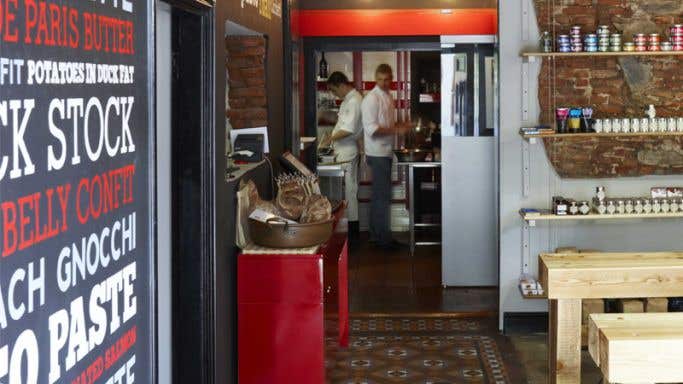Cape Town’s natural beauty is so striking that it is impossible for any chef to compete.
At the restaurant in The Twelve Apostles hotel, Azure, the team behind energetic chef Christo Pretorius delivered a rich lamb terrine, a fillet of fresh, flaky kingklip and a luscious dessert of various combinations of milk and honey (inspired, he told me, by his morning bowl of porridge). But I found it difficult to take my eyes off the panoramic view of the sun setting on the ocean directly outside to take too many notes.
That was one extra reason perhaps why I so enjoyed the five hours I spent walking along Bree Street downtown. The views of nearby Table Mountain only appear infrequently, allowing me to concentrate on the various exciting food and wine places that are emerging here.
Bree means 'wide' in Afrikaans and so although this emerging nucleus of independent food and drink enthusiasts has the air of the collective phenomenon that has over recent years so successfully transformed Borough Market in London and so much of Brooklyn, this street has a feel of its own. There is a sense of space here along the broad pavements, although how much longer this will last once its obvious pleasure factor is fully recognised, I am not sure.
This street also comes with its own sense of history. Heritage Square, half way along, contains the oldest vine in the country, planted in the 18th century, right by two city wineries that are both now managed by Frenchmen.
Just above it on Wale Street is the Atlas Trading Company, a long-established Muslim-run company that has been trading in spices, nuts and dried fruit for decades and which every enthusiastic visiting home cook should visit before packing their suitcase.
These herbs go into the sausages that hang in the Frankie Fenner Meat Merchants 250 metres away, a basement space that sells remarkable knives crafted in the garage of Scott Lowry, a teacher by day, while one corner is devolved in the evening to the Publik Wine Bar.
Further along Bree Street is Jason Bakery that produces a great coffee, a red cappuccino made from rooibos leaves, as well as breads and sandwiches. A couple of blocks further north is Sababa, a small space that specialises in Middle Eastern food that would remind any Londoner, if they were to close their eyes and inhale deeply, of an Ottolenghi cafe or Honey & Co.
My overriding goal, however, was to eat at Chefs Warehouse & Canteen , and to reacquaint myself with the exceptional cooking style of Irish-born Liam Tomlin and the hospitality of his English-born wife, Jan.
What I did not appreciate as I walked past at 10.30 am, catching a glimpse of the proprietors doing those menial tasks that are an integral part of running any small business – he was putting the stools out on to the tables on the pavement, dressed, as ever, in a crisp white chef’s jacket, while she was brushing the floor – was that this visit would result in my best-value meal for a very long time. What ensued were eight different dishes that cost R380 for two (£21) and comprised more than enough excellent food for both of us.
These dishes are called ‘tapas’ but bear no recognition to the Spanish original. This is South Africa, after all, where appetites are large and therefore portion sizes have to be, too. In my opinion these are the same size, and of as good a quality, as any first course served in a top restaurant in Europe or the US.
The menu, which Tomlin creates every morning with input from his young chefs, reflects his itinerant career. We began with a most satisfying tomato risotto before moving on to four dishes that reflected his years in Sydney, Australia: thin slices of raw beef with oyster mayonnaise; seared and peppered tuna with soba noodles; venison with roast pears and an intricate mixture of curls of squid, fine slices of octopus and chorizo laced with a potato salad. Finally, two dishes that came from Tomlin’s Irish background: a hefty piece of roasted bone marrow topped with a shrimp crust and, finally, the most delicate interpretation of a lemon posset in a glass topped with raspberries served alongside a glass jug of cool raspberry sauce.
These dishes are served on large, round wooden trays in one side of the building while the other sells kitchen equipment and cookery books and doubles as a hospitable waiting room because after just a year the Tomlins have developed a loyal following. This is due, somewhat inadvertently, to a highly effective seating layout.
Tomlin’s customers sit reasonably comfortably at a series of six communal wooden tables, four inside and two outside, seating no more than 30 at any one time. This style of food allows the unflappable Jan to turn the tables, without taking reservations, twice at lunch and twice before last orders, which they fixed at an immovable 8 pm even before they opened to ensure that they saw something of each other outside the restaurant.
Relaxing over a glass of Pinot Noir, Tomlin confessed that as he approaches his 50th birthday, he is now cooking more happily than ever before in his career, a feeling I was definitely able to pick up on. Then he added with a smile, 'And we may even be starting to make some money.'
The Twelve Apostles
Frankie Fenner Meat Merchants
Publik
Jason Bakery
Sababa
Chefs Warehouse & Canteen

